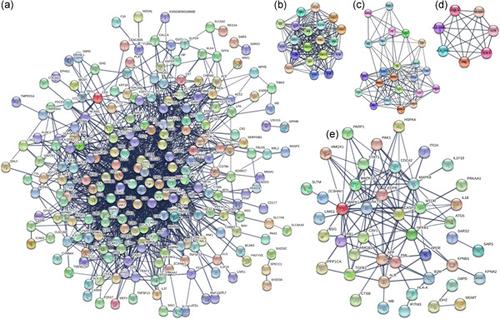当前位置:
X-MOL 学术
›
J. Cell. Physiol.
›
论文详情
Our official English website, www.x-mol.net, welcomes your
feedback! (Note: you will need to create a separate account there.)
Quantitative proteomics reveals a broad‐spectrum antiviral property of ivermectin, benefiting for COVID‐19 treatment
Journal of Cellular Physiology ( IF 4.5 ) Pub Date : 2020-09-22 , DOI: 10.1002/jcp.30055 Na Li 1, 2, 3 , Lingfeng Zhao 4 , Xianquan Zhan 1, 2, 3, 5, 6
Journal of Cellular Physiology ( IF 4.5 ) Pub Date : 2020-09-22 , DOI: 10.1002/jcp.30055 Na Li 1, 2, 3 , Lingfeng Zhao 4 , Xianquan Zhan 1, 2, 3, 5, 6
Affiliation

|
Viruses such as human cytomegalovirus (HCMV), human papillomavirus (HPV), Epstein–Barr virus (EBV), human immunodeficiency virus (HIV), and coronavirus (severe acute respiratory syndrome coronavirus 2 [SARS‐CoV‐2]) represent a great burden to human health worldwide. FDA‐approved anti‐parasite drug ivermectin is also an antibacterial, antiviral, and anticancer agent, which offers more potentiality to improve global public health, and it can effectively inhibit the replication of SARS‐CoV‐2 in vitro. This study sought to identify ivermectin‐related virus infection pathway alterations in human ovarian cancer cells. Stable isotope labeling by amino acids in cell culture (SILAC) quantitative proteomics was used to analyze human ovarian cancer cells TOV‐21G treated with and without ivermectin (20 μmol/L) for 24 h, which identified 4447 ivermectin‐related proteins in ovarian cancer cells. Pathway network analysis revealed four statistically significant antiviral pathways, including HCMV, HPV, EBV, and HIV1 infection pathways. Interestingly, compared with the reported 284 SARS‐CoV‐2/COVID‐19‐related genes from GencLip3, we identified 52 SARS‐CoV‐2/COVID‐19‐related protein alterations when treated with and without ivermectin. Protein–protein network (PPI) was constructed based on the interactions between 284 SARS‐CoV‐2/COVID‐19‐related genes and between 52 SARS‐CoV‐2/COVID‐19‐related proteins regulated by ivermectin. Molecular complex detection analysis of PPI network identified three hub modules, including cytokines and growth factor family, MAP kinase and G‐protein family, and HLA class proteins. Gene Ontology analysis revealed 10 statistically significant cellular components, 13 molecular functions, and 11 biological processes. These findings demonstrate the broad‐spectrum antiviral property of ivermectin benefiting for COVID‐19 treatment in the context of predictive, preventive, and personalized medicine in virus‐related diseases.
中文翻译:

定量蛋白质组学揭示伊维菌素的广谱抗病毒特性,有利于 COVID-19 治疗
人类巨细胞病毒 (HCMV)、人类乳头瘤病毒 (HPV)、爱泼斯坦-巴尔病毒 (EBV)、人类免疫缺陷病毒 (HIV) 和冠状病毒(严重急性呼吸系统综合症冠状病毒 2 [SARS-CoV-2])等病毒代表了一个伟大的对全世界人类健康造成的负担。FDA 批准的抗寄生虫药物伊维菌素也是一种抗菌、抗病毒和抗癌剂,为改善全球公共卫生提供了更大的潜力,并能有效抑制 SARS-CoV-2 的体外复制。本研究旨在确定人卵巢癌细胞中伊维菌素相关病毒感染途径的改变。细胞培养物中氨基酸稳定同位素标记 (SILAC) 定量蛋白质组学用于分析用和不用伊维菌素 (20 μmol/L) 处理 24 小时的人卵巢癌细胞 TOV-21G,在卵巢癌细胞中鉴定出 4447 种伊维菌素相关蛋白。通路网络分析揭示了四种具有统计学意义的抗病毒通路,包括 HCMV、HPV、EBV 和 HIV1 感染通路。有趣的是,与已报道的来自 GencLip3 的 284 个 SARS-CoV-2/COVID-19 相关基因相比,我们在使用和不使用伊维菌素治疗时发现了 52 个 SARS-CoV-2/COVID-19 相关蛋白改变。蛋白质-蛋白质网络 (PPI) 是基于 284 个 SARS-CoV-2/COVID-19 相关基因之间的相互作用和 52 个由伊维菌素调节的 SARS-CoV-2/COVID-19 相关蛋白质之间的相互作用构建的。PPI 网络的分子复合物检测分析确定了三个中枢模块,包括细胞因子和生长因子家族、MAP 激酶和 G 蛋白家族以及 HLA 类蛋白。基因本体论分析揭示了 10 个具有统计学意义的细胞成分、13 个分子功能和 11 个生物过程。这些发现表明,在病毒相关疾病的预测、预防和个性化医学背景下,伊维菌素的广谱抗病毒特性有利于 COVID-19 的治疗。
更新日期:2020-09-22
中文翻译:

定量蛋白质组学揭示伊维菌素的广谱抗病毒特性,有利于 COVID-19 治疗
人类巨细胞病毒 (HCMV)、人类乳头瘤病毒 (HPV)、爱泼斯坦-巴尔病毒 (EBV)、人类免疫缺陷病毒 (HIV) 和冠状病毒(严重急性呼吸系统综合症冠状病毒 2 [SARS-CoV-2])等病毒代表了一个伟大的对全世界人类健康造成的负担。FDA 批准的抗寄生虫药物伊维菌素也是一种抗菌、抗病毒和抗癌剂,为改善全球公共卫生提供了更大的潜力,并能有效抑制 SARS-CoV-2 的体外复制。本研究旨在确定人卵巢癌细胞中伊维菌素相关病毒感染途径的改变。细胞培养物中氨基酸稳定同位素标记 (SILAC) 定量蛋白质组学用于分析用和不用伊维菌素 (20 μmol/L) 处理 24 小时的人卵巢癌细胞 TOV-21G,在卵巢癌细胞中鉴定出 4447 种伊维菌素相关蛋白。通路网络分析揭示了四种具有统计学意义的抗病毒通路,包括 HCMV、HPV、EBV 和 HIV1 感染通路。有趣的是,与已报道的来自 GencLip3 的 284 个 SARS-CoV-2/COVID-19 相关基因相比,我们在使用和不使用伊维菌素治疗时发现了 52 个 SARS-CoV-2/COVID-19 相关蛋白改变。蛋白质-蛋白质网络 (PPI) 是基于 284 个 SARS-CoV-2/COVID-19 相关基因之间的相互作用和 52 个由伊维菌素调节的 SARS-CoV-2/COVID-19 相关蛋白质之间的相互作用构建的。PPI 网络的分子复合物检测分析确定了三个中枢模块,包括细胞因子和生长因子家族、MAP 激酶和 G 蛋白家族以及 HLA 类蛋白。基因本体论分析揭示了 10 个具有统计学意义的细胞成分、13 个分子功能和 11 个生物过程。这些发现表明,在病毒相关疾病的预测、预防和个性化医学背景下,伊维菌素的广谱抗病毒特性有利于 COVID-19 的治疗。











































 京公网安备 11010802027423号
京公网安备 11010802027423号